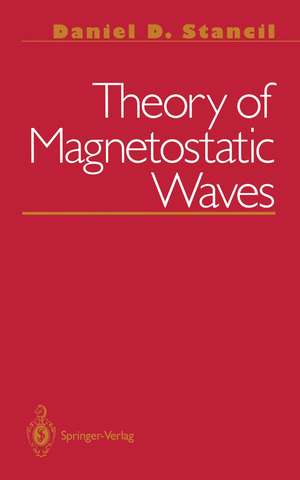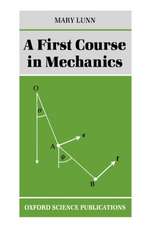Theory of Magnetostatic Waves
Autor Daniel D Stancilen Limba Engleză Paperback – 16 dec 2011
Preț: 693.71 lei
Preț vechi: 816.13 lei
-15% Nou
Puncte Express: 1041
Preț estimativ în valută:
132.76€ • 138.09$ • 109.60£
132.76€ • 138.09$ • 109.60£
Carte tipărită la comandă
Livrare economică 14-28 aprilie
Preluare comenzi: 021 569.72.76
Specificații
ISBN-13: 9781461393405
ISBN-10: 146139340X
Pagini: 232
Ilustrații: XI, 214 p.
Dimensiuni: 155 x 235 x 12 mm
Greutate: 0.33 kg
Ediția:Softcover reprint of the original 1st ed. 1993
Editura: Springer
Colecția Springer
Locul publicării:New York, NY, United States
ISBN-10: 146139340X
Pagini: 232
Ilustrații: XI, 214 p.
Dimensiuni: 155 x 235 x 12 mm
Greutate: 0.33 kg
Ediția:Softcover reprint of the original 1st ed. 1993
Editura: Springer
Colecția Springer
Locul publicării:New York, NY, United States
Public țintă
ResearchCuprins
1. Introduction to Magnetism.- 1.1. Magnetic Properties of Materials.- 1.2. Spinning Top.- 1.3. Magnetism.- 1.4. Magnetic Moments of Atoms and Ions.- 1.5. Elements Important to Magnetism.- Problems.- 2. Magnetic Susceptibilities.- 2.1. Diamagnetism.- 2.2. Paramagnetism.- 2.3. Weiss Theory of Ferromagnetism.- 2.4. Néel Theory of Ferrimagnetism.- 2.5. Exchange Interaction.- 2.6. Magnetocrystalline Anisotropy.- 2.7. Polder Susceptibility Tensor.- 2.8. Magnetic Damping.- Problems.- 3. Electromagnetic Waves in Anisotropic Dispersive Media.- 3.1. Maxwell’s Equations.- 3.2. Constitutive Relations.- 3.3. Instantaneous Poynting Theorem.- 3.4. Complex Poynting Theorem.- 3.5. Energy Densities in Lossless Dispersive Media.- 3.6. Wave Equations.- 3.7. Polarization of the Electromagnetic Fields.- 3.8. Group and Energy Velocities.- 3.9. Plane Waves in a Magnetized Ferrite.- 3.10. The Magnetostatic Approximation.- Problems.- 4. Magnetostatic Modes.- 4.1. Walker’s Equation.- 4.2. Spin Waves.- 4.3. Uniform Precession Modes.- 4.4. Normally Magnetized Film: Forward Volume Waves.- 4.5. Tangentially Magnetized Film: Backward Volume Waves.- 4.6. Tangentially Magnetized Film: Surface Waves.- Problems.- 5. Propagation Characteristics and Excitation of Magnetostatic Waves.- 5.1. Energy Velocities for Magnetostatic Waves.- 5.2. Propagation Loss.- 5.3. Mode Orthogonality and Normalization.- 5.4. Excitation of Magnetostatic Waves.- Problems.- 6. Variational Formulation for Magnetostatic Modes.- 6.1. General Problem Statement.- 6.2. Calculus of Variations.- 6.3. Small-Signal Functional for Ferrites.- 6.4. Interpretation of the Functional.- 6.5. Stationary Formulas.- 6.6. Stationary Formula Examples with Forward Volume Waves.- Problems.- 7. Optical-Magnetostatic Wave Interactions.- 7.1. Symmetric Dielectric Waveguides.- 7.2. Magneto-Optical Interactions.- 7.3. Coupled-Mode Theory.- 7.4. Scattering of Optical Guided Modes by Magnetostatic Waves.- 7.5. Anisotropic Bragg Diffraction.- Problems.- Appendix: Properties of Yttrium Iron Garnet.














